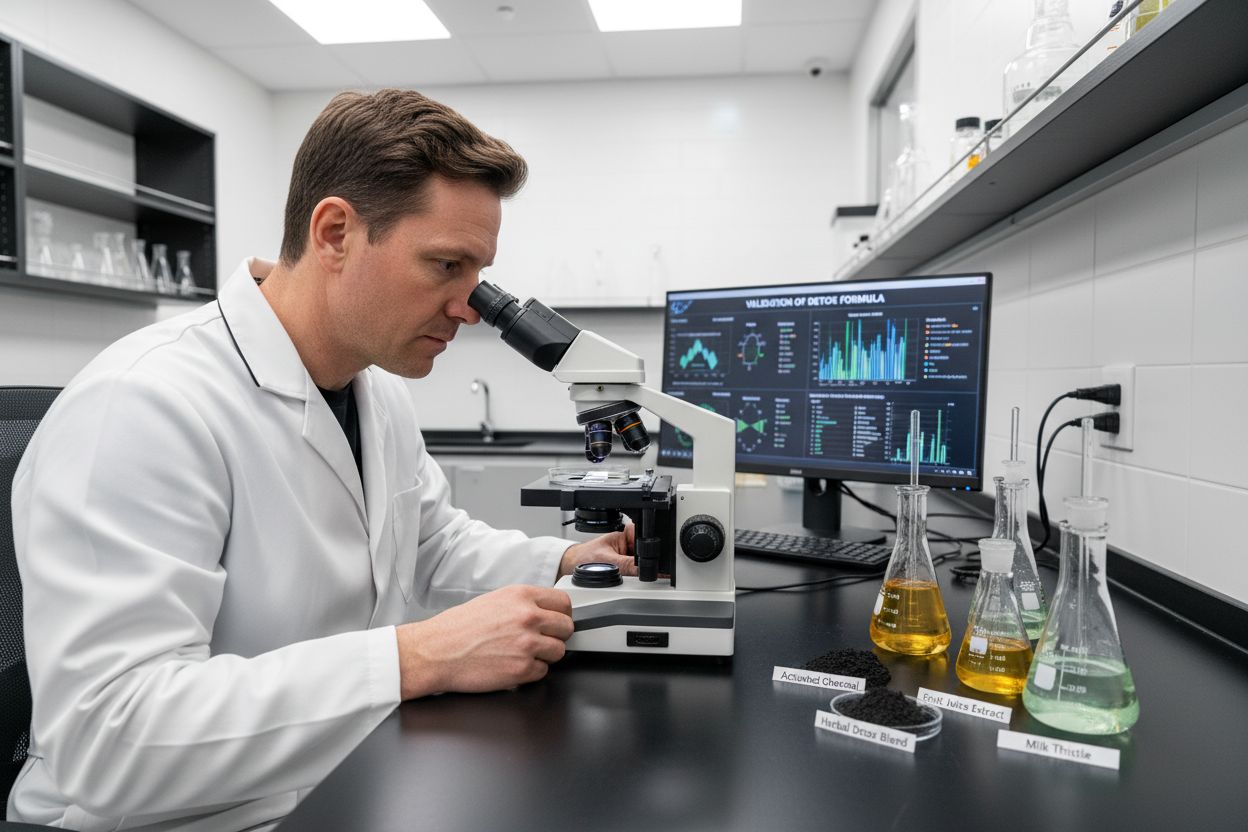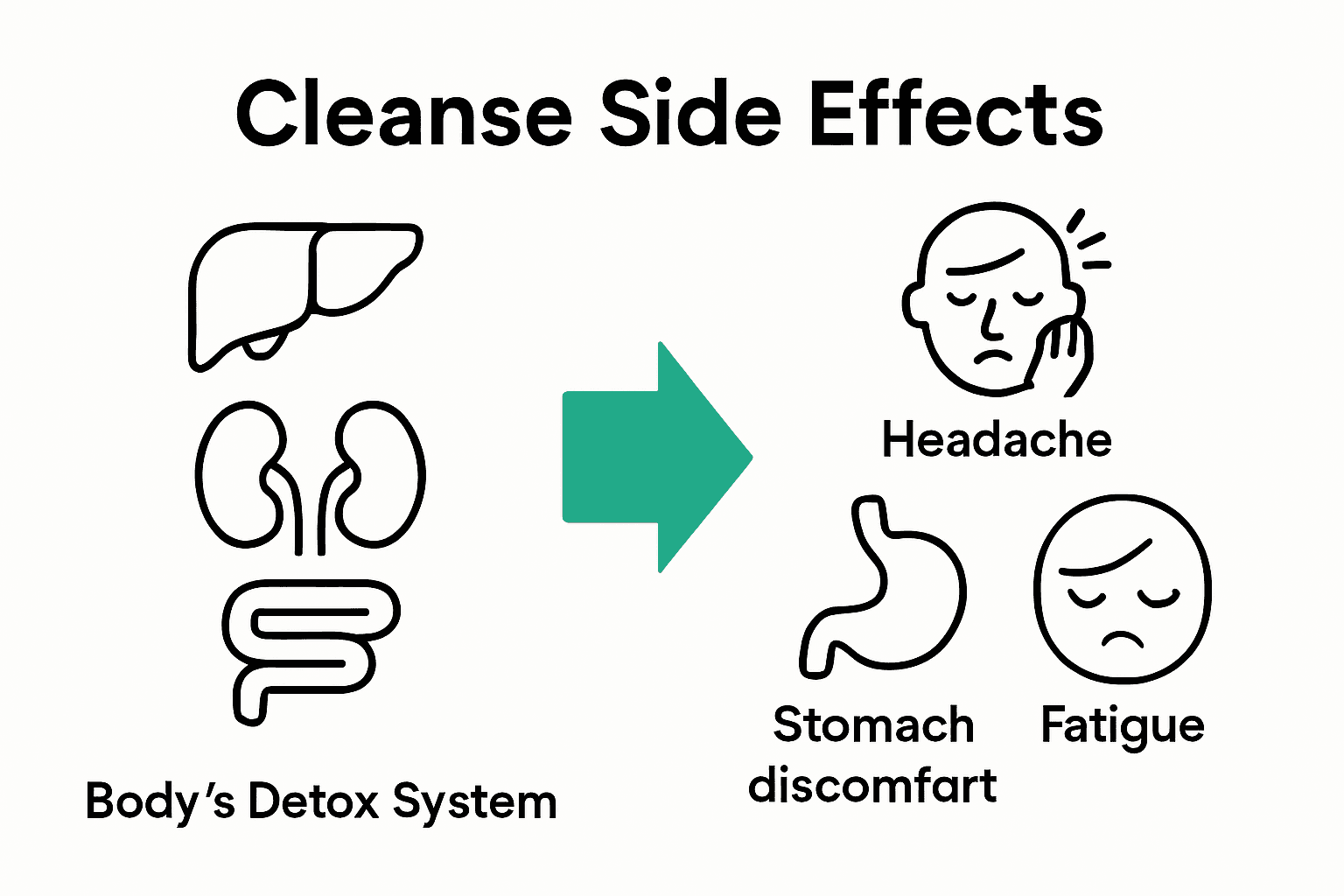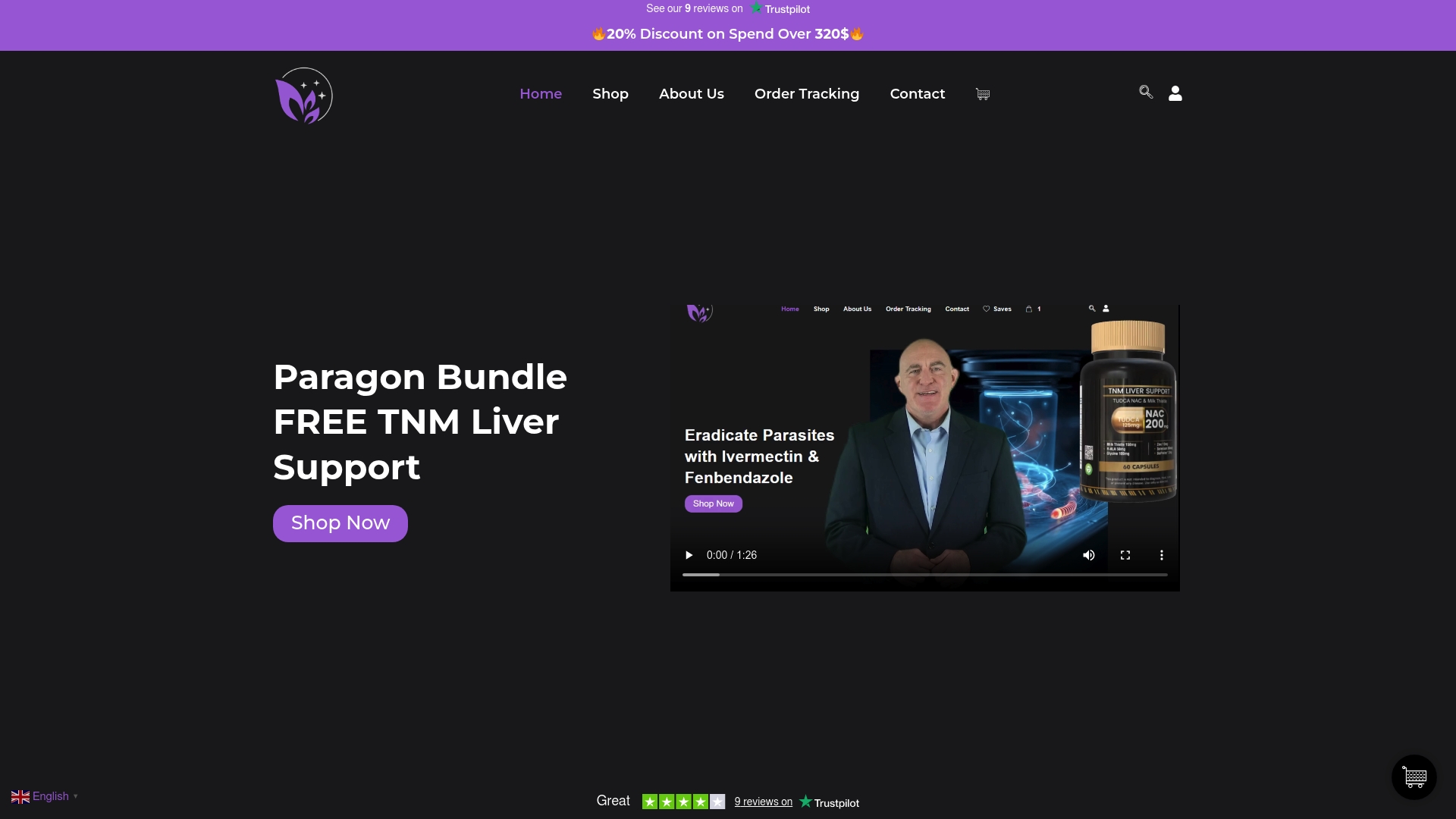Nearly one in five adults has tried a detox cleanse hoping for a quick health fix. The promise of removing mysterious toxins draws attention, but are these cleanses really necessary? Many wellness programs blend fasting, juices, and supplements, yet the science behind them remains shaky. Understanding what detox cleanses truly involve and separating fact from myth can help you make choices that support real health rather than fall for bold marketing claims.
Key Takeaways
| Point | Details |
|---|---|
| Natural Detoxification | The body has its own sophisticated detox systems (liver, kidneys, etc.), negating the need for external detox cleanses. |
| Skepticism of Detox Claims | Most detox methods lack scientific evidence for their efficacy and can present health risks. |
| Consult Healthcare Professionals | Always seek medical advice before starting any intensive detox program, especially if you have underlying health conditions. |
| Healthy Lifestyle Choices | Prioritize balanced nutrition, hydration, and adequate rest over extreme detox diets for sustainable health benefits. |
Table of Contents
- Detox Cleanses Defined And Common Myths
- Types Of Detox Cleanses And Ingredients
- Typical Side Effects And Symptom Timeline
- Factors Influencing Detox Reaction Severity
- Managing Risks And Supporting Recovery
Detox Cleanses Defined and Common Myths
A detox cleanse sounds like a magical solution promising instant health renewal. But what exactly are these trendy wellness practices? According to the National Center for Complementary and Integrative Health, detox cleanses are alternative health protocols involving fasting, juicing, herbal supplements, colon cleansing, and other methods allegedly designed to remove unspecified “toxins” from the body.
What Science Really Says
Read more about holistic detox approaches, but understand this critical fact: Most scientific authorities are skeptical of detox claims. According to research from Wikipedia’s medical overview, these practices often lack:
- Clearly defined “toxins”
- Credible scientific evidence
- Proven long-term health benefits
The core myth perpetuated by many detox programs is the notion that our bodies require external intervention to eliminate harmful substances. In reality, human bodies possess sophisticated natural detoxification systems – primarily the liver, kidneys, digestive tract, lungs, and skin – which continuously filter and eliminate waste products without special diets or expensive supplements.
While some detox approaches might offer temporary feelings of wellness, medical experts caution against viewing them as comprehensive health solutions. The most effective “detox” remains consistent healthy lifestyle choices: balanced nutrition, regular exercise, adequate hydration, and sufficient sleep. Your body is already an incredibly sophisticated self-cleaning system – sometimes, the best intervention is simply supporting its natural processes.
Types of Detox Cleanses and Ingredients
Detox cleanses come in numerous forms, each promising miraculous body purification. Learn more about building a natural detox protocol, but first understand the primary types of detox cleansing methods.
Popular Detox Cleanse Approaches
Here’s a comparison of common detox cleanse types, their typical ingredients, and associated risks:
| Detox Method | Typical Ingredients | Claimed Benefits | Key Risks |
|---|---|---|---|
| Juice Fasting | Fruit juices Vegetable juices |
Rapid weight loss Energy boost |
Blood sugar spikes Nutrient deficiency |
| Herbal Cleanse | Senna Triphala Milk thistle |
Enhanced liver function Digestive aid |
Cramping Dehydration Electrolyte loss |
| Water Fasting | Water only | “Reset” digestion Remove toxins |
Fatigue Dizziness Muscle loss |
| Activated Charcoal | Activated charcoal supplements | Toxin absorption | Nutrient loss Medication interference Constipation |
The most common detox cleanse types include:
- Juice Fasting: According to Wikipedia, this involves consuming only fruit and vegetable juices while abstaining from solid foods. Despite its popularity, this method lacks scientific substantiation for claimed health benefits.
- Herbal Cleanses: Utilizing specific herbs believed to support liver and digestive system functions
- Water Fasting: Complete abstinence from food, consuming only water
- Activated Charcoal Cleanse: A controversial method involving charcoal consumption
Ingredients and Potential Risks
Activated charcoal cleanses present significant concerns. Wikipedia notes that while promoted as a detoxification method, there is no medical evidence supporting its health benefits. Worse, charcoal can potentially:
- Adsorb essential nutrients
- Interfere with medication absorption
- Create potential digestive complications
Most detox ingredients fall into several categories: herbal supplements, fruit and vegetable extracts, minerals, and proprietary blend mixtures. However, the critical takeaway is that these cleanses often lack rigorous scientific validation.
 Your body’s natural detoxification systems – liver, kidneys, and digestive tract – remain the most effective mechanism for eliminating toxins and maintaining internal balance.
Your body’s natural detoxification systems – liver, kidneys, and digestive tract – remain the most effective mechanism for eliminating toxins and maintaining internal balance.
Typical Side Effects and Symptom Timeline
Detox cleanse side effects can range from mild discomfort to more serious health complications. Learn more about potential detox risks, understanding the symptom progression is crucial for anyone considering a cleansing protocol.
First 48 Hours: Initial Reactions
According to research on Ayurvedic cleanses, the first two days typically present the most intense symptoms, which may include:
- Gastrointestinal Disruptions: Bloating, cramps, diarrhea, or constipation
- Energy Fluctuations: Significant fatigue or sudden energy shifts
- Neurological Responses: Headaches (often triggered by caffeine or sugar withdrawal)
Comprehensive Side Effect Profile
Beyond initial reactions, participants might experience a complex array of symptoms:
- Mood changes and emotional volatility
- Sleep disturbances or insomnia
- Skin reactions (sometimes called a “detox rash”)
- Flu-like symptoms
- Occasional dizziness or low blood pressure
It’s critical to recognize that while these symptoms are common, they are not necessarily indicators of effective detoxification.
Most side effects represent your body’s stress response rather than genuine toxin elimination. The majority of symptoms typically peak within the first 48 hours and gradually taper off, though individual experiences can vary significantly based on overall health, cleanse intensity, and personal metabolic factors.

Factors Influencing Detox Reaction Severity
Detox reaction severity isn’t a one-size-fits-all experience. Explore the liver’s critical role in detoxification, as individual health factors dramatically impact how your body responds to cleansing protocols.
Health Condition Vulnerabilities
According to the National Center for Complementary and Integrative Health, certain populations face heightened risks during detox programs. Specific health conditions that can significantly influence detox reaction severity include:
- Diabetes
- Kidney disease
- Heart disease
- Compromised immune systems
- Chronic digestive disorders
Key Reaction Modulating Factors
Multiple elements determine the intensity of detox reactions:
- Herbal Intensity: Strong purgative herbs like senna or triphala can trigger more extreme responses
- Individual Health Status: Overall wellness and existing metabolic efficiency
- Gut Sensitivity: Pre-existing digestive system resilience
- Medication Interactions: Potential conflicts with blood thinners or other prescription medications
- Dietary Restriction Degree: Extreme dietary changes amplify potential side effects
Research from Ayurvedic medicine sources emphasizes that unpasteurized juices and aggressive cleansing methods pose particular risks. Your body’s unique biochemistry means that a detox protocol tolerated by one person might create significant stress for another. Always consult healthcare professionals before initiating any intense cleansing regimen, especially if you have pre-existing medical conditions or are taking concurrent medications.
Managing Risks and Supporting Recovery
Detox recovery demands strategic, informed approaches to minimize potential health complications. Learn about holistic wellness protocols, understanding that professional guidance is crucial during any intensive cleansing process.
Critical Risk Mitigation Strategies
According to the National Center for Complementary and Integrative Health, managing detox risks requires proactive steps:
- Consult healthcare providers before starting any detox program
- Monitor for signs of electrolyte imbalance
- Stay vigilant about potential nutrient deficiencies
- Maintain proper hydration levels
- Watch for symptoms of metabolic disruption
Recovery Support Techniques
Harvard Health emphasizes several key recommendations for safer detoxification:
- Hydration: Drink plenty of water to support bodily functions
- Balanced Nutrition: Consume nutrient-dense foods
- Gradual Transition: Avoid extreme dietary changes
- Rest: Allow your body adequate recovery time
- Electrolyte Management: Replenish essential minerals
The most effective detox strategy isn’t about harsh restrictions, but supporting your body’s natural elimination processes. Prioritize whole foods, gentle movement, adequate sleep, and professional medical guidance. Remember: Your body’s intrinsic detoxification systems are far more sophisticated than any commercial cleanse could ever replicate.
Take Control of Detox Cleanse Side Effects with Targeted Wellness Support
If you have ever struggled with unpredictable side effects from detox cleanses, you are not alone. Many people feel worried about nutrient deficiencies, discomfort, and the uncertainty of how their bodies will react to new cleansing protocols. As highlighted in this article, the challenge is real when your body is coping with fatigue, digestive upsets, or even medication interference. Instead of guessing at what works, you can support your natural detoxification systems with smarter, safer tools designed for your unique needs.

Do not let the fear of side effects stop you from striving for better health. Discover high-quality, pharmaceutical-grade detox and parasite cleanse solutions formulated for holistic wellness on our main site. Our detailed product descriptions help you choose the right support for your lifestyle, whether you are seeking advanced liver support complexes or gentle natural detox supplements. Visit https://mahoneyinter.com now to explore limited-time discounts and find answers to your health questions. Take the first step to a safer, more confident detox experience today.
Frequently Asked Questions
What are the common side effects of detox cleanses?
Detox cleanses can lead to gastrointestinal disruptions, energy fluctuations, mood changes, sleep disturbances, skin reactions, flu-like symptoms, and occasional dizziness. These symptoms are often the body’s stress response rather than indications of effective detoxification.
How long do detox cleanse side effects last?
Most side effects typically peak within the first 48 hours of starting a detox cleanse and gradually taper off. However, individual experiences may vary based on overall health and the intensity of the cleanse.
Are there specific health conditions that can influence reactions to detox cleanses?
Yes, certain health conditions such as diabetes, kidney disease, heart disease, compromised immune systems, and chronic digestive disorders can significantly increase the risks and severity of detox reactions.
How can I manage risks associated with detox cleanses?
To manage risks, it’s essential to consult healthcare providers before starting any detox program, monitor for signs of electrolyte imbalance, maintain proper hydration, and avoid extreme dietary changes. Supporting recovery with balanced nutrition and adequate rest is also crucial.






